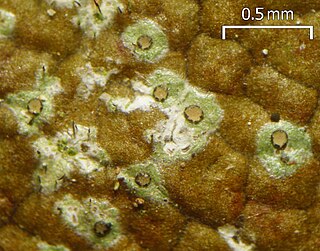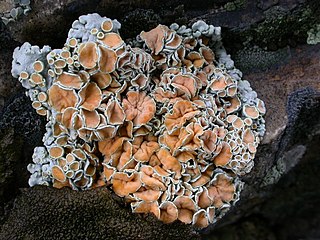
Serenoa repens, commonly known as saw palmetto, is the sole species currently classified in the genus Serenoa. It is a small palm, growing to a maximum height around 7–10 ft (2.1–3.0 m). It is endemic to the subtropical and tropical Southeastern United States, most commonly along the south Atlantic and Gulf Coastal plains and sand hills. It grows in clumps or dense thickets in sandy coastal areas, and as undergrowth in pine woods or hardwood hammocks.

The Gomphillaceae are a family of lichen-forming fungi in the order Graphidales. Species in this family are found mostly in tropical regions.
Echinoplaca is a genus of lichens in the family Gomphillaceae.

Tricharia is a genus of lichens in the family Gomphillaceae. It has an estimated 30 species.
Dicerandra cornutissima is a rare species of flowering plant in the mint family known by the common name longspurred mint, longspurred balm, and Robin's mint. It is endemic to Florida in the United States. It is found in Marion County, and possibly Sumter County, but it may have been totally extirpated from the latter. There are 15 known occurrences remaining. The plant was federally listed as an endangered species in 1985.

Rhizoplaca chrysoleuca is a pale yellowish-green to gray-green umbilicate foiliose lichen in the Lecanoraceae family. It was first described in 1791 by English botanist Sir James Edward Smith as Lichen chrysoleucus; Friedrich Wilhelm Zopf transferred it to the genus Rhizoplaca in 1905.
Tricharia vainioi is a species of foliicolous lichen in the family Gomphillaceae. It is widely distributed, having been recorded in Africa, Asia, Australia, Central and South America.

Gyalideopsis buckii is a species of bark-dwelling lichen in the family Gomphillaceae. It is found in the United States.
Enterographa serusiauxii is a species of leaf-dwelling lichen in the family Roccellaceae. It is found in Guadeloupe.
Phacopsis australis is a species of lichenicolous (lichen-dwelling) fungus in the family Parmeliaceae. It is found in a few locations in South Africa, where it grows on the thalli of several species of the leafy lichen genus Xanthoparmelia. Unlike other members of genus Phacopsis, the fungus does not induce the formation of galls in its host.
Aderkomyces sikkimensis is a species of foliicolous (leaf-dwelling) crustose lichen in the family Gomphillaceae. Found in India, it was formally described as a new species in 2006 by Athokpam Pinokiyo, Krishna Pal Singh, and Robert Lücking. The type specimen was collected by the first author from a subtropical forest near Damthang (Sikkim). It has also been recorded from the Darjeeling district of West Bengal. The specific epithet refers to the region of the type locality.
Coenogonium pineti is a species of crustose lichen in the family Coenogoniaceae. It was first formally described by Erik Acharius in 1810, as Lecidea pineti. Robert Lücking and H. Thorsten Lumbsch transferred it to Coenogonium in 2004 after molecular phylogenetic analysis suggested its placement in that genus. The lichen has a widespread distribution in cooler, temperate regions of the Northern Hemisphere, but has also been recorded from southeastern mainland Australia and Tasmania.
Phylloblastia bielczykiae is a species of foliicolous (leaf-dwelling) lichen in the family Verrucariaceae. Found in Bolivia, it was formally described as a new species in 2008 by lichenologists Adam Flakus and Robert Lücking. The type specimen was collected near lake Copaiba ; there, in an isolated island of lowland Amazon rainforest along a savanna, it was found growing on the leaves of a vascular plant. It is only known from the type locality. The species epithet honours the Polish lichenologist Urszula Bielczyk.
Gyalectidium yahriae is an uncommon species of crustose lichen in the family Gomphillaceae. It occurs in Florida and Papua New Guinea, recorded growing on bark in the former location and on both bark and on wood in the latter.
Allographa pedunculata is a species of script lichen in the family Graphidaceae, discovered in the Galápagos Islands. The species is characterized by its distinctly stalked lirellae and contains norstictic acid. It is similar to other species in the Graphis nuda species complex but has the longest ascospores in the group.
Gyalectidium floridense is a species of foliicolous (leaf-dwelling), crustose lichen in the family Gomphillaceae. It is found in the southeastern United States, where it grows on the leaves of Citrus and palmetto.
Austrotrema is a genus of lichen-forming fungi in the family Graphidaceae. It is primarily found in the Australian-Southeast Asian region. The genus is characterized by small, pore-like apothecia with a double margin, faintly amyloid ascospores, and stictic acid chemistry. Austrotrema species grow on tree bark and have a continuous thallus with a cortex that is prosoplectenchymatous–featuring densely packed, filamentous fungal hyphae that run parallel to the surface of the lichen, creating a compact and firm texture. The genus is closely related to Thelotrema and Leucodecton, but can be distinguished from them based on molecular phylogenetic data, specific morphological traits, and its secondary chemistry. Currently, Austrotrema comprises three species.
Trichothelium angustisporum is a species of corticolous (bark-dwelling), crustose lichen in the family Trichotheliaceae. It is found in subtropical regions of Guyana and the Atlantic Forest of Brazil. The lichen was formally described as a new species in 2004 by lichenologists Marcela Eugenia da Silva Cáceres and Robert Lücking. The species epithet refers to its narrow and elongated ascospores.
Echinoplaca basalis is a species of foliicolous (leaf-dwelling) lichen in the family Gomphillaceae. It is found in the Southeastern United States.




